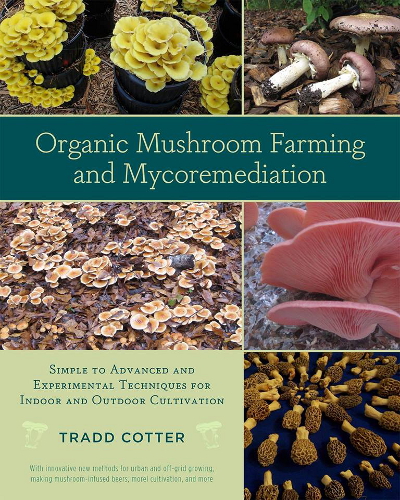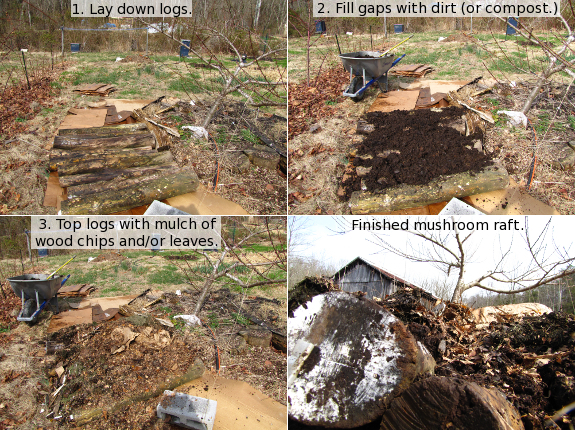
Organic Mushroom Farming and Mycoremediation
 Although Tradd Cotter's Organic Mushroom Farming and Mycoremediation deserves a full lunchtime series...I already wrote one after listening to his inspiring lectures.
So, instead, I'll simply tell you that this beautifully illustrated
book is a must-read for anyone interested in homestead-scale mushroom
production. You'll learn more in-depth information about many of the
home-propagation techniques I've posted about previously, will be
inspired to try out mycoremediation
in your chicken coop, and much more. Then dive deeper into topics like
producing a slurry of morel spores and associated microbes to grow this
elusive species at home, or experiment with propagating shiitakes
without a lab by stacking thinly sliced logs separated by pieces of damp
cardboard.
Although Tradd Cotter's Organic Mushroom Farming and Mycoremediation deserves a full lunchtime series...I already wrote one after listening to his inspiring lectures.
So, instead, I'll simply tell you that this beautifully illustrated
book is a must-read for anyone interested in homestead-scale mushroom
production. You'll learn more in-depth information about many of the
home-propagation techniques I've posted about previously, will be
inspired to try out mycoremediation
in your chicken coop, and much more. Then dive deeper into topics like
producing a slurry of morel spores and associated microbes to grow this
elusive species at home, or experiment with propagating shiitakes
without a lab by stacking thinly sliced logs separated by pieces of damp
cardboard.
I really can't do Tradd's
book justice in a single post, so I'm merely going to sum up some
information on which mushroom species are best to grow in specific ways.
Tradd has a great section at the end of the book giving
species-by-species cultivation techniques for twenty-four types of
mushrooms, and he also breaks the species down into difficulty
categories. Based on that data, raw beginners who want to fruit their
mushrooms outdoors should consider black poplar mushrooms, wood ears,
reishi, brick tops, oysters and elm oysters, shiitakes, stropharia, and
turkey tails.

The book also clued me in to why my rafts
didn't do as well as I thought they would --- only reishi, nameko,
black poplar, brick top, and maitake are recommended for this type of
cultivation. Stumps,
similarly, are best for maitake, chicken of the woods, reishi, enoki,
oysters, and beefsteaks, with the tradeoff being that stumps take longer
to start to fruit than logs do, but that they then tend give you many
more years of harvests before petering out. Finally, if you want to grow mushrooms on cardboard, oysters, blewits, and stropharia are a good choice (at least during the vegetative stage).
Although I have a
tendency to focus on the easiest types of mushroom growing (namely
oysters and shiitakes seasonally fruiting on logs), Mark likes the idea
of faster production using sawdust, wood chips, coffee grounds and other
substances in containers. And Tradd succeeded in knocking out one of my
roadblocks to Mark's proposal, namely the constant use of throwaway
plastic bags. Instead, the mushroom guru recommends putting your growing
substrate in PVC pipes, nursery pots, or five-gallon buckets, all of
which can be modified with holes and sanitized in a 10% bleach-water
solution to allow reuse. Using these methods, you can see mushrooms as
soon as three weeks after inoculation when growing oysters on coffee
grounds --- too bad we don't drink that beverage or have a coffee shop
nearby!
In the end, Tradd's book is just as inspiring as his lectures were, but
the contents are much more meaty. I read the book slowly over the course
of a couple of months and recommend you do the same to enjoy the full
effect. Other mushroom books --- notably those by Paul Stamets --- will be a good supplement for the mushroom enthusiast, but Organic Mushroom Farming and Mycoremediation
has now risen to the top of my list of recommended mushroom books for
the homestead fungiphile. This book will be staying on my shelf for
years to come and I expect it will inspire many mushroom experiments.
Stay tuned for details as we try to propagate shiitakes using the log
method and perhaps grow some oyster mushrooms on old jeans.
Want more in-depth information? Browse through our books.
Or explore more posts by date or by subject.
About us: Anna Hess and Mark Hamilton spent over a decade living self-sufficiently in the mountains of Virginia before moving north to start over from scratch in the foothills of Ohio. They've experimented with permaculture, no-till gardening, trailersteading, home-based microbusinesses and much more, writing about their adventures in both blogs and books.
Want to be notified when new comments are posted on this page? Click on the RSS button after you add a comment to subscribe to the comment feed, or simply check the box beside "email replies to me" while writing your comment.
- Remove comment
